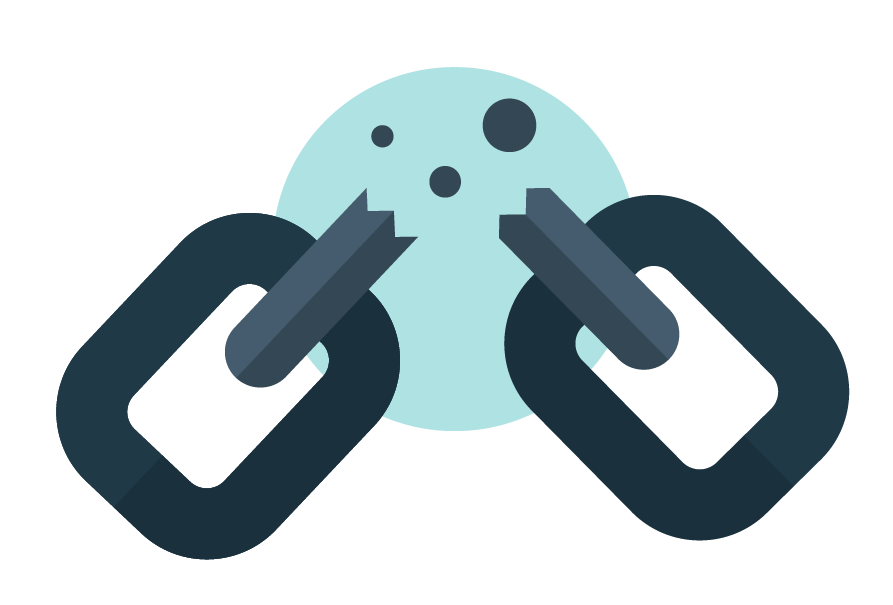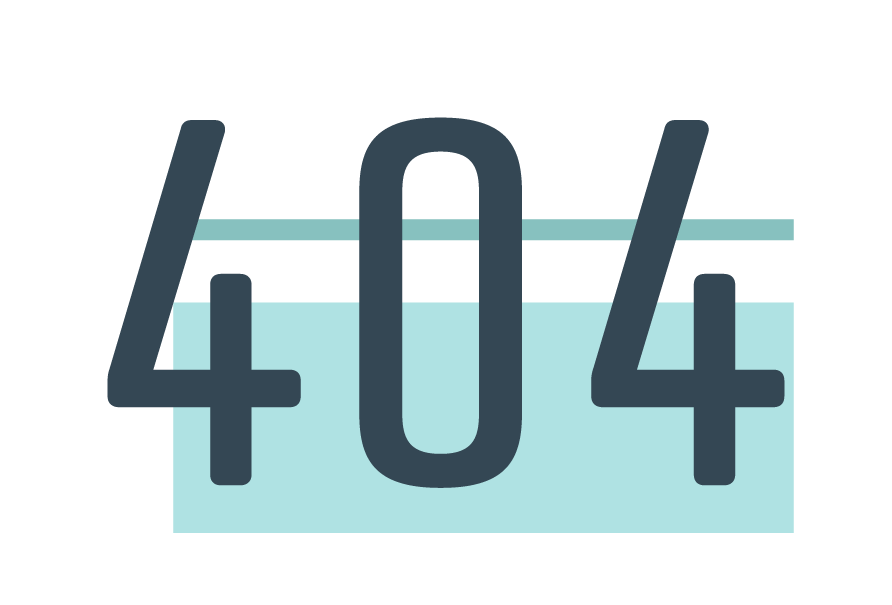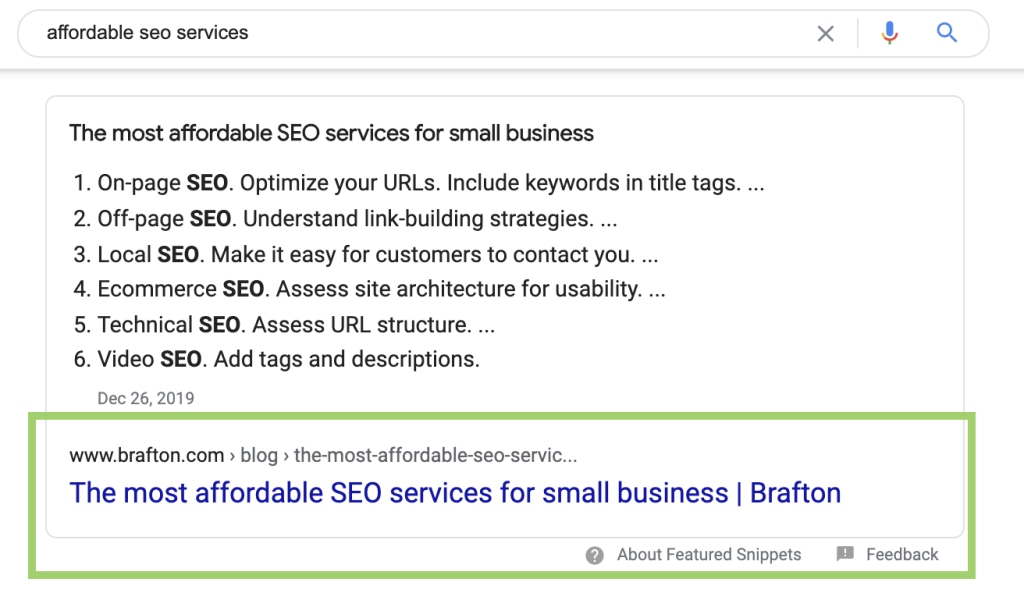Regardless of whether your business is brand new or has been around for a while, ranking highly on Google’s results needs to be a key part of your marketing strategy. Not sure where to start? We’ve got you covered with this comprehensive guide for how to rank on Google.
Table of Contents
1. Intro to SEO (And Keyword Rankings)

Organic search and traffic need to be at the forefront of your SEO strategy. That means everything you do — from developing content strategies to running social media campaigns — should aim to increase organic website traffic.
To do this, you need to publish high-quality content that matches specific search queries. But let’s rewind for a second — what exactly is this search query we speak of? While a keyword refers to a group of words associated with a particular topic, a search query is the real-life word combo that people enter into a search engine (like Google).
A search query can seek to:
Regardless of the type of search a user makes, the results populate on a search engine results page (SERP). Searchers want fast, accurate and helpful results. Google determines which results to show based on how well the page’s content matches the search intent — AKA how well the content answers the user’s query.
A driving factor that influences website ranking is how well the keywords in your content match the search query. That’s where search engine optimization (SEO) comes in. By creating keyword-driven content, Google will find your website more helpful than others — leading to a higher rank. And the better you rank on the SERP, the more organic search traffic your website will receive.
- Find information: Question-based searches, such as “how to play the piano” or “where does vanilla flavoring come from?”
- Navigate the web: Searches looking to navigate to a specific website, social media page, news article, video or blog post. Examples include “E! Online Betty White’s cause of death” and “2022 social advertising benchmarks.”
- Make a transaction: Searches with the intention of making a purchase. These queries often include keywords like “order,” “buy” and “purchase.”
Before we dive into how to improve your search engine rank, let’s make sure we’re on the same page about why having a high Google ranking matters for your business. The answer is simple: People — 99% of people, according to Advanced Web Ranking — will not click on a Page 2 result of a Google search. So if you’re looking to bring in new business, maintaining a first-page rank is essential.
How SEO Strategies Improve Your Google Rank
OK, so we know that if you’re not maintaining a high Google rank, you’re missing out on millions of website clicks (which can translate to thousands of dollars in revenue). So make sure you maintain a top ranking on the first page of Google, right? Too bad that’s easier said than done.
Getting your website to achieve a high SERP ranking involves implementing an effective strategy and then maintaining it. Not only are you using keywords and Domain Authority to convince Google that your website is worthy of a top spot, but you also need to continuously outrank competitors who are also trying to hold onto their rank.
There are a lot of factors that contribute to how Google determines SERP rankings, such as:
Therefore, your SEO strategy should center around achieving all of these factors, and possibly even a few more, which is why SEO isn’t a one-and-done execution. Your SEO strategy will have many moving parts and require your team to continuously evaluate its results (which most SEO specialists do through Google Analytics) and make plenty of changes along the way.
This means that establishing and maintaining a high site ranking takes time. You won’t be able to snap your fingers and get a top listing overnight. By taking the time to execute an effective SEO strategy and continuously monitor your SEO performance, you will eventually generate higher SERP rankings and increase website traffic for your business.
3. How to Rank on Google: Everything You Need to Know
To rank highly on Google, your SEO strategy will need to involve:
Understanding Google’s Algorithm
Google’s search algorithm will create the foundation of your SEO strategy — which is why you need to understand exactly how it operates.
First, Google uses a code called a spider to “crawl” the web. As it moves through the different pages, the spider records the page code for websites that it identifies as valuable. This process is known as indexing, and only indexed pages show up on a Google search. But remember, these bits of code are spiders, not grasshoppers — meaning they cannot jump to a new page on their own. Instead, the spiders use links — hence why internal links are critical for SEO — to explore and index a website.
Here’s a video from Google to help marketers understand how the search process works:
What does this have to with search engine rank? When you enter a search query, Google isn’t populating everything on the internet — just the pages its spiders have indexed. That means your website can only appear on a SERP if it has been indexed by Google.
How do spiders determine what gets indexed? They follow Google’s Search algorithm — which is continuously updated — to identify if a page should be indexed or not. When there’s a new search, Google sifts through its indexed websites to create a list of results.
However, Google doesn’t simply populate a SERP at random. Remember those ranking factors discussed above? They come into play here. Google uses those ranking factors to decide the order in which the links appear.
You can view Google rank as a two-pronged approach. First, you need to get your website indexed. Second, you need to make sure the content on your website follows Google’s ranking factors, so your site can rank on the first page.
Building Backlinks
A backlink is an external website that sends users to your page. They’re different from internal links, which help people move through your website.
Backlinks have always played a critical role in SEO, and they will need to be a prominent part of your SEO strategy. But why are they so important? A few reasons include:

Helping spiders index your page: Rather than submitting a new site to a search engine, spiders can find and index your pages when crawling a site that features a backlink.

Enhancing page authority: Google’s algorithm considers backlinks an indicator of how credible a website is. Therefore, as links to your site increase, so should your search engine rank.

Driving more website traffic: Backlinks send people to your site, thus improving website traffic.
With that in mind, your SEO strategy should feature these link building strategies:

Reclaim Unlinked Brand Mentions
Closely monitor all mentions of your brand online. Whenever you find one without a link, reach out to the publisher and request it be added. Most of the time, if a website is already talking about your company, the publisher won’t mind adding a backlink to your site — in fact, they’ll probably appreciate the external link. To find and track your brand mentions, use tools like Semrush, Buzzsumo and Google Trends.

Leverage Your Competitor’s Broken Links
If your competitor is hosting a broken link on a third-party website — for example, you get sent to a 404 page after clicking the link — that’s a link building opportunity for you. Reach out to the website, alert them of the issue and provide a new link to your website. Just remember that if you take this approach, your link needs to lead to a page that the user will find helpful.

Get Media Exposure With HARO
PR sources like HARO empower you to collaborate with journalists and give your brand high-quality exposure. All you have to do is sign up as a source, select the topics of your interest and submit an answer whenever you find a query that matches your area of expertise. If you want to give HARO a try with a more personal touch, follow #journorequest on Twitter.

Reach Out to Bloggers, Editors and Influencers
When you reach out directly to content creators, you can form partnerships with high-profile professionals in your industry. In doing so, you can build natural-looking and authentic backlinks through blogs, social media posts, news articles, resource pages, directories and more.

Produce Compelling Media
High-quality media like infographics and videos are more likely to be shared. Once you design these pieces, include an HTML code snippet with a link back to your website. This way, when others share the media, they’ll also be linking to your site.

Use Optimized Anchor Text
Search engines prioritize backlinks that use relevant anchor text. The text tells Google and website visitors where your page is sending them, making your content more user-friendly.
Some of the best practices for writing useful anchor text include:
- Using natural and descriptive wording.
- Not adding keywords just for the sake of it (keyword stuffing).
- Keeping linked text succinct and concise.
- Being specific so the reader has a clear understanding of where the link is taking them.
Keep in mind that if you’re partnering with an outside organization, journalist or influencer, whoever is creating the link will determine the anchor text. However, you can request certain types of anchor text when working with a link exchange partnership.
Creating High-Quality Content
SEO and content marketing are two peas in a pod. SEO is the process of increasing website traffic and maintaining high rankings in search engines. And to do that, you need engaging content. Simply put, you cannot achieve your SEO goals without high-quality content.
However, notice when we talk about content, we’re not referring to whipping together a few blogs. No — we mean creating content with substance. Not only should your content include relevant keywords and internal links, but it also needs to be helpful, informative and readable.
Why? There is a ton of content out there — which is why Google indexes the pages it deems worthy of receiving a search engine rank. Therefore, the more valuable your website content is, the better your search engine ranking will be.
Your focus needs to be on not just producing content with keywords and links but producing website content that creates positive UX — so much that users frequently return or refer others to your site. Content strategies that can help you achieve this include:
- Adding internal links to help the reader navigate your site.
- Creating visuals and interactive media to educate and engage with users.
- Producing content that gets granular on a topic rather than just covering the basics.
- Reoptimizing — like adding missing information, updating statistics or repurposing through infographics — to increase the relevancy of your content.
Include Tutorials in Your Content Strategy
While there are many different types of marketing collateral you can utilize, one specific type absolutely needs to be a part of your content marketing strategy: tutorials. These content pieces teach customers about a product or service — preferably ones related to your business. Examples include:

Webinars.

Videos.

Infographics.

How-to blogs and lists.
A good tutorial concisely conveys helpful information that the user is looking for and provides a positive UX. And as we know, UX plays a critical role in determining search engine rank. Thus, engaging and helpful tutorials can help you rank higher on Google.
Conducting Thorough Keyword Research
There’s no arguing that to rank on Google, your content must include keywords. Without them, Google won’t recognize how your content matches the search query, which will prevent you from ranking. But how do we find those keywords? By performing comprehensive keyword research.
Keyword research is one of the first steps in the content creation process. You’ll want to have a broad topic in mind that relates to your business. Then you’ll use keyword research to determine what phrases and words people are searching related to that topic.
The process sounds simple, but it gets more complex because, as Internet Live Stats reveals reveal, there are over 40,000 search queries every second — meaning there are trillions of keywords to choose from. But you can use specific metrics to narrow down which target keywords to include in your content.
While there are many metrics for professionals to utilize when researching keywords, the two most critical ones are search volume — how many people search for a word within a specified time range — and keyword difficulty — how difficult it is to rank for that keyword.
To find your target keywords, you can use SEO tools like:
- Semrush.
- Moz.
- Ahrefs.
- Google Keyword Planner (although this platform is primarily for keyword discovery as it does not display difficulty metrics).
- Spyfu.
Keeping Search Intent as Your Strategy’s North Star
In 2015, Google created RankBrain, which uses machine learning to interpret new searches and translate them to other related queries, generating the most useful pages for a searcher. RankBrain works in conjunction with Google’s Hummingbird algorithm to better understand search intent based on keywords and content.
What does this mean for SEO? Search intent is a leading factor for Google rank, so all of your SEO tactics need to center around creating an interesting, easy and positive experience on your website. If you want to achieve or maintain a high rank on Google, you must create content that Google deems worthy of displaying on a SERP.
You can optimize your content around user intent by understanding what people are searching for — keyword research — and then catering your content to match those queries. Combine excellent search intent with UX tactics — like easy website navigation, good readability and fast site speeds — and Google will find your website to be worthy of a top SERP spot.
Targeting Featured Snippets With Your Content
In 2014, Google released another new creation to improve UX: Featured Snippets. These are the answer boxes that appear at the top of a results page. This SERP feature provides a fast answer to a searcher’s question, allowing them to receive information without actually clicking on the link.

Featured Snippets can come in the form of lists, paragraphs, videos, tables and more. And while people can gather information quickly from the snippet, many still visit the attached website. HubSpot Featured Snippet research found that when a website maintained a Featured Snippet spot, its click-through rate (CTR) increased by as much as 114%.
The takeaway: You want that Featured Snippet spot. The catch: So does everyone else.
Therefore, you need to create content that Google can easily turn into a Featured Snippet. To do that, you should:
- Include lists, tables and steps whenever possible — especially when explaining how to do something.
- Answer specific questions in your content.
- Generate high-quality, user-focused and entertaining content.
- Leave out the fluff by getting straight to the point.
Optimize Rich Snippets as much as possible.
Implementing On-Page Optimization Tactics
While you‘ll be using high-quality content to improve where you rank on Google, you’ll also need to implement key on-page optimization tactics to comply with Google’s algorithms. These include (but are not limited to) creating:
- Keyword targeted and user-friendly headings and subheadings.
- Keyword-optimized content — while avoiding Black Hat tactics like keyword stuffing.
- Meta descriptions that encourage clicks.
- Click-worthy and keyword-targeted title tags.
- A responsive and mobile-friendly website with fast pagespeed.
- Optimized URLs.
- Image alt tags.
- Internal links that connect the pages of your website.
Additionally, there are plenty of SEO tools that you can use to help identify what on-page optimization tactics your content is missing. A prime example is the easy-to-use Moz On-Page Grader Tool. Simply plug your URL and target keyword into the grader, and the tool will produce a page optimization score and checklist of recommended fixes to boost your SEO. The tool is an excellent resource for anyone looking to improve page strength, and it can be used for any website.
Increasing Your Click-Through Rate
Here are two more metrics that Google analyzes when determining your search engine rank: CTR and bounce rate.
Your CTR tells Google the percentage of people who visit your website after seeing it appear in a paid or organic search. The ratio comes from dividing the number of clicks a website receives by impressions (times seen). A higher CTR means people are visiting your website after seeing it on a SERP — which to Google, means that your website is providing useful information.
Your bounce rate reflects how many single-page sessions your website maintains. A single-page session is when a user visits your site but exits without triggering another request. Websites want to maintain a low bounce rate, which is calculated by dividing single-page sessions by all other sessions. A low bounce rate tells Google that people are clicking on your website and performing additional actions, so your content must provide value.
However, keep in mind that blog posts typically see a higher bounce rate than transactional or service web pages — and that’s not necessarily a bad thing. A moderate to high bounce rate on a blog post means that searchers are getting the answers to their questions and then leaving the site, which is good. These website visitors are likely at the very top of the funnel and probably not looking to purchase anything or engage further with your brand just yet. As of now, they want a fast and accurate answer. And if your blog post provided that, then they’ll likely return.
Therefore, when assessing your blog’s strength, it’s better to look at dwell time — the average session duration divided by the total number of sessions. If users are landing on a blog page and immediately leaving, the session duration is low. This indicates to Google that the content on your blog did not match what the user was searching for.
Identifying and Troubleshooting Low Keyword Rankings
If you’re generating new content, you’ll need to do some keyword research to determine which keywords to target. For those who have content but aren’t ranking on the first page of Google — or aren’t ranking at all — you need to troubleshoot for potential problems with your content. And that starts with keywords.
You might have valuable content on your website, but your low ranking in Google is preventing people from seeing it. This happens if you’re not using the right keywords in your content. Remember: Your keywords should match the words and phrases your target audience is searching for. If not, Google won’t recognize that your content could be valuable, resulting in a lower ranking.
To troubleshoot keyword problems, you can use Google Search Console (which must be installed and connected to your Google Analytics account). Google Search Console will identify:
- Low impression pages that need to be re-optimized or re-indexed.
- Low-ranking pages that could use fresh content with new keywords.
- Which pages on your website have declined in rank.
Once you know which pages need help, you can perform keyword research to determine which words or phrases your low-ranking pages are missing. Then you can either refresh, add to or rewrite the content with the target keywords.
Re-Optimizing Under Performing Content
Writing excellent content one time for a target term may be enough to get your site on Page 1 — for a while. But digital competition never rests, and soon your competitors may be eying your hard-earned position. If your content begins to slump down Page 1, you’ll want to revisit your content to see if it’s still hitting the mark.
TF-IDF tools help with this. TF-IDF stands for term frequency-inverse document frequency, and it identifies the most important terms related to a given keyword. This type of process is incorporated into search engine algorithms as well as content creation tools such as:
When using these tools, enter your target term as well as the content written. The tool will grade your content using the top-performing content on that web for that same keyword as a benchmark. Then, it’ll make suggestions for any missing topics and terms that you can address throughout the content.
Incorporating Social Media Into Your SEO Strategy
While social media does not directly impact your keyword rankings, having a strong social media presence can help you achieve better brand visibility and get more organic website traffic. As your brand reputation grows, so does your website authority — meaning that Google may prioritize your content over a lesser-known brand. Additionally, a large social media following can lead to more backlinks — which is great for SEO — and helps your content reach more users.
Creating Interactive and Multimedia Content
Google populates SERPs with content that it’s determined is likely to answer the search query. Sometimes, that doesn’t include written content at all.
Take for example the query, “how to knit socks” — this is a hard skill to learn by reading text alone. A video tutorial is much more helpful, and that’s exactly what you’ll find on Page 1 for that search phrase. Creating interactive and multimedia content can be a great way to set yourself apart from the other brands on the web that are targeting the same SERPs as you. For each of your keywords, spend some time analyzing the SERP to determine what types of multimedia content are most beneficial for that topic. You might find that one of these types of content is a better match for your target phrase:

Video, like screenshare tutorials or animation explainers.

Infographics that highlight important stats.

Quizzes that help answer questions (or simply entertain the user).

Interactive maps and charts that let users dive into data.
By creating content your audience will interact with, you’re creating a reason for them to spend more time on the page and on your website. Plus — more importantly — you’re providing an engaging and memorable experience for them, which will underscore your brand’s authority.
Using Localized Long-Tail Keywords
SEO is a lot to digest, but it can be difficult for businesses with limited resources to implement — especially if they’re competing with established brands for keywords and ranking positions. However, businesses can shift their focus to local SEO tactics, which means optimizing a website for location-specific search queries.
For example: A ‘Mom-and-Pop’ pizza shop might not have the budget or Domain Authority to rank higher than established businesses like Dominos and Pizza Hut. But the small business may be able to outrank them for search queries that include long-tail or location-based keywords.
Long-tail keywords consist of three to five words, making them very specific. Smaller brands can use localized long-tail keywords to rank on the first page of Google. Rather than compete for the keyword “pizza,” an independent pizza shop could target these long-tail keywords instead:

Best pizza shop in [town/city/county name].

Pizza shop near me.

Gluten-free pizza near me.

Late-night pizza [town/city/county name].
Remember: Google considers a user’s location when populating a SERP. So when people search these location-specific terms, a ‘Mom-and-Pop’ shop can outrank a national brand.
Start increasing Your Rank on Google
There’s a lot that goes into determining where you rank on Google — so much that it’s completely understandable to feel overwhelmed. But there are plenty of resources that break down different SEO tactics and help you understand which ones you need to implement into your content marketing strategy. A great example of such a resource is our newsletter — which you can sign up for right here:








